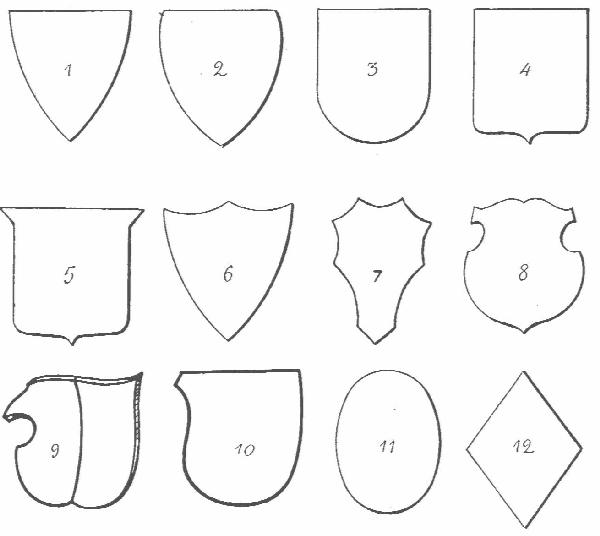
The first shields seen on seals follow military fashions of the day, because they are still close to their actual battlefield counterparts. Shield no 1 is typical of the 13th c, although shields are narrower at the top and the angles are more rounded. The classic 12th c. shape (not shown) is the mandorla (in Italian, ad unghia) or almond shape, which is like no 1 but with the top edge in semi-circle. (Neubecker has a picture of an actual Swiss shield whose top edge was sawed off to adapt it to changing fashion, and turn it from almond shape to no 1 shape).
No 2 is the classic 14th-15th c. type. The rounded bottom (no 3) appears in the Iberian peninsula at the end of the 12th c. and spreads to Southern France and Savoy by the mid-13th c. and the rest of Europe. The advantage of that shape is that it accomodates quartering more easily (the 3d and 4th quarter do not suffer as much). The modern French shield (no 4) appears in the 16th c. and remains in use down to our times. An English variant has triangular winglets at the top (no 5). A variant of shield 6 is the typical Venitian shield: the side edges are straight, and the top center peak rises higher and ends with a little horizontal edge. The testa di cavallo (horse-head, no 7) is a Renaissance invention and remains an Italian favorite. The shield "en cartouche" (no 8) is a Renaissance elaboration on the targe (no 9), with a slit to rest the tilting lance on the side, typical of Germanic countries. The oval shield (no 11) replaced in Italy in the 15th c. the almond-shape which was until then the preferred shape. It becomes very common in the 17th and 18th c., notably for clergymen. Certain asymmetric rococo shields are obviously from the 18th century.
The shape of the shield can yield important clues when trying to identify a coat of arms, by suggesting locations and time periods. Pastoureau's Traité has 6 pages on the subject (though he does warn about relying too much on this type of evidence).
